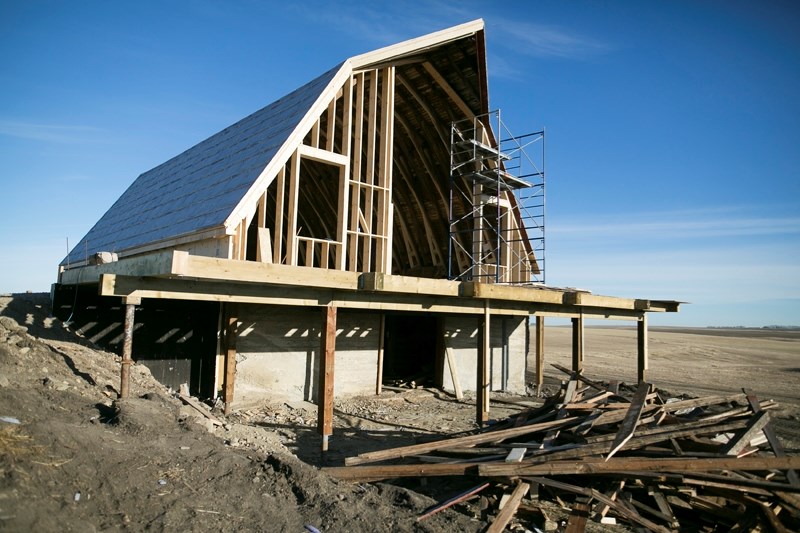CREMONA – A 100-plus-year-old barn just east of the village is being restored by its new owner.
Debora Rice-Salomons bought the property about a year ago and has been rebuilding and restoring both the barn and the house, which had both belonged to homesteader John (Jack) and wife Caroline Rattray.
Although there is no firm date on when the barn was originally built, neighbour Lynn Reid, who grew up in the area, estimates that it was before 1909.
"Most of the structures in the area were built around that time," said Reid. "We know that Jack Rattray, who was a homesteader, worked in a sawmill in Elkton. My uncle (Alan Reid) thinks he was working for his lumber there to build a barn from 1903 on, but before 1909."
John (Jack) Rattray applied for his homestead in 1903, coming from Ontario to the area near Cremona. His wife Caroline came later to join him. Rattray originally built a shanty-type house before building the house that is still there now. He had 20 acres of land broken by 1907.
Rice-Salomons told the Gazette she was interested in restoring an old barn like the one her family had growing up.
"I'm a Rice, originally from Torrington," she said. "My grandparents had a barn; they homesteaded near Torrington. They always had this barn. As a little girl I would go my grandparents' farm, and they had this barn and they would have these barn dances.
"One of my last memories of my father was him taking me to this barn dance at my grandparents'. He passed away in the 1960s when I was seven years old. Since that time I've had a dream of having a barn like that, and having events and dances and now weddings."
Rice-Salomons said she has spent the last 20 years planning her barn venture.
"Last year I made a decision to complete my dream," she said. "I went looking for a property and happened to drive by and saw the place for sale. The barn on the Rattray property looks very much like the Rice barn I remember as a child."
Rice-Salomons bought the property in February 2017. The property had previously belonged to John and Caroline's only son Grant Rattray, who passed away in 2014.
After purchasing the property, Rice-Salomons was told by one neighbor that she would have to tear down the buildings and that it would be cheaper to build a new barn.
"That's not the point – the point of this is to maintain buildings like this barn," she said. "We've had lots of visitors from the community, and lots of feedback that keeping these old buildings, especially the barns, is very important to the community."
Neighbour Reid said it's great to see the house and barn in the process of being restored.
"It's been an icon in the community since Grant (Rattray) put a green roof on it," said Reid. "Everybody has noticed this house. It's a great venture, one that everybody is looking forward to. Barn dances just aren't around anymore. It's going to be a special place.
"Of course, we live in a beautiful country too. The scenery is gorgeous; lots of wildlife. I'm looking forward to it."
Reid said the barn had become quite dilapidated over the years.
Reid added that he has several antiques he is looking forward to displaying in the barn.
"For the next generation, a lot of that stuff is meaningless," he said. "So it's good to save it."
Rice-Salomons said the house itself was built in 1915.
"It's an Eaton's catalogue home," she said. "A fellow I talked to said his grandfather went with a team of horses and a wagon to Carstairs to pick the lumber package up off the train."
Rice-Salomons said that there weren't many lumber/hardware stores back in the early 20th century and many homesteaders ordered houses from a catalogue, which came in pieces that had to be put together.
"Because of the wooden structure, a lot of them have fallen into disrepair or become granaries," she said. "So it's nice to be able to have the historical home as well."
Rice-Salomons said that the community is looking forward to the first barn dance from what she's heard.
Reid said that barn dances were very popular back in the early days.
"When a barn was built they would always have a barn dance," he said. "It was just what they did to kind of initiate the barn. Before it got dirty they had a dance. I might add after a while the people who insured the barns would cancel the insurance during the barn dance."
"People would drive 20 miles to go to a barn dance," said Rice-Salomons. "It's what you did on a Friday night."
Rice-Salomons said that the fact that the house and barn have mostly survived for so long is a testament to the workmanship of the day. She said the barn was originally made for both horses and cattle.
"This is a combination horse and cattle barn," she said. "The south end has the stalls for the heavy horses they would have used to clear the land. Outside the stalls there were hooks to hang the harness. The north end of the barn was for cattle."
Rice-Salomons said the barn was fairly unique in that it had an alleyway through the centre and on either end of the stalls.
"Mr. Rattray could walk up and down and feed his horses," she said. "Whereas most barns were much smaller and you just had to shove the horses out of the way. This farmer was very wealthy."



